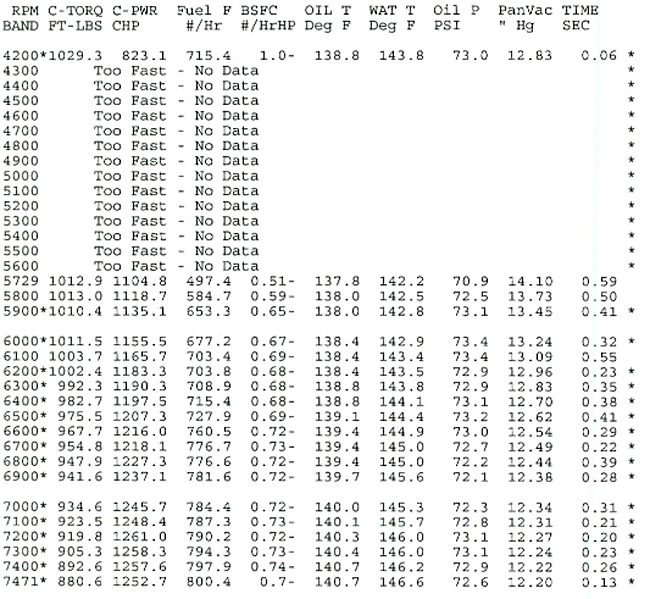Darren Tedder owns what’s probably the cleanest 8-second ’71 Cuda ever. He was a Top 10 finisher in the 2006 Hot Rod Pump Gas Drags, where we got to know him a little, and had his car featured in the mag. You may have also seen the car in the 2008 Dynomax Power To The Wheels competition, a chassis-dyno contest where the Cuda won the all-motor class putting 956 hp to the tires. He’s DTHemi on our forums.
Darren’s Dynomax winning combo is a 654ci, all-aluminum Hemi that makes 1,261 hp on E85 from the pump. He suspects that it’s the biggest-cube Hemi ever with the stock bore spacing and deck height. It has 4.565-inch bores and a whopping 5.00-inch stroke.
After the photos, read a bunch of in-depth notes from Darren himself regarding the construction of this monster.
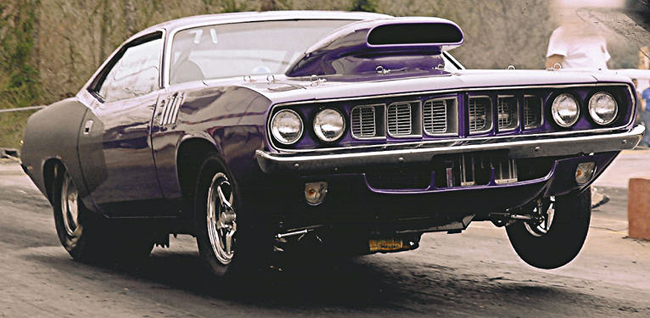
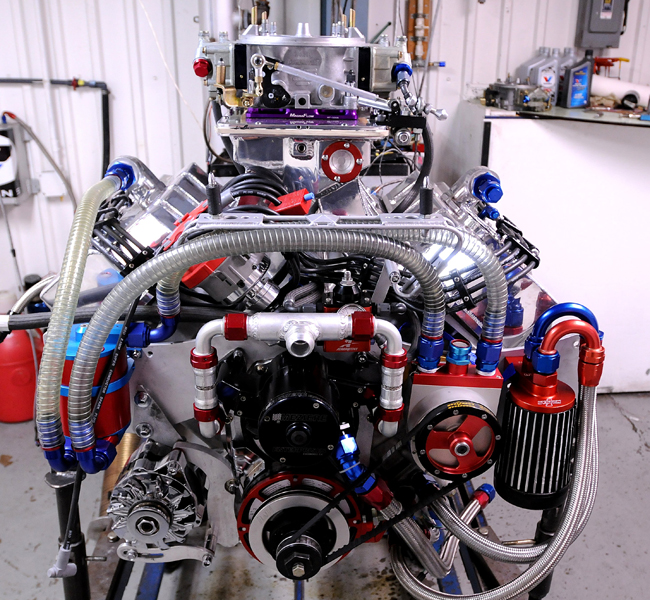
The crank is a Callies billet ultra lightweight crank at 62 pounds. It has big-block Chevy rod journals at the BBC width. Callico coated Clevite P-series full-groove bearings are used on the mains. I know the P isn’t a common choice, but I’ve tried all the other concentric codes and they look better on teardown than the others. We use them on big Fords too, and the Ford crank is very similar to a Chrysler.
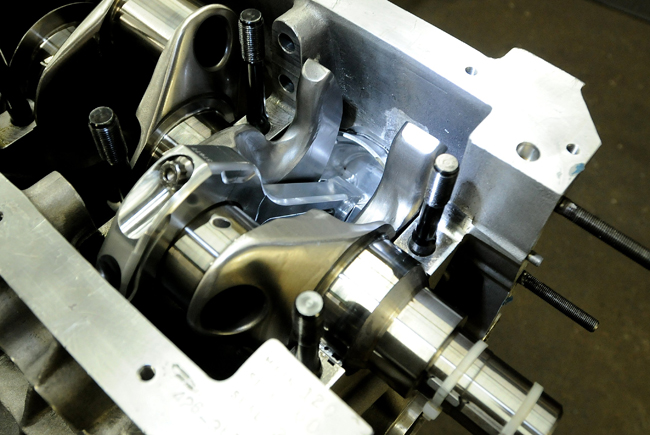
The pistons are custom billet units by CP, as they had no Hemi forgings in the bore size required. They’re very light for a high compression hemi piston at 590 grams. They feature 0.990-inch casadium-coated pins with wire locks and are gas ported. The rings are 0.043-inch backcut top Hellfire, a 0.043 backcut second, and a 3MM low-tension oil ring with split radius drain backs. The compression ratio is 16.0:1. One benefit of the large bore, aside from the obvious, is the wide, flat quench area all the way around the piston (except for the intake pocket area) that allows for straight, even length vertical gas porting holes that are also in the quench area outside the head chamber. The gas ports being in quench really hammers the top ring into the walls making a good seal.
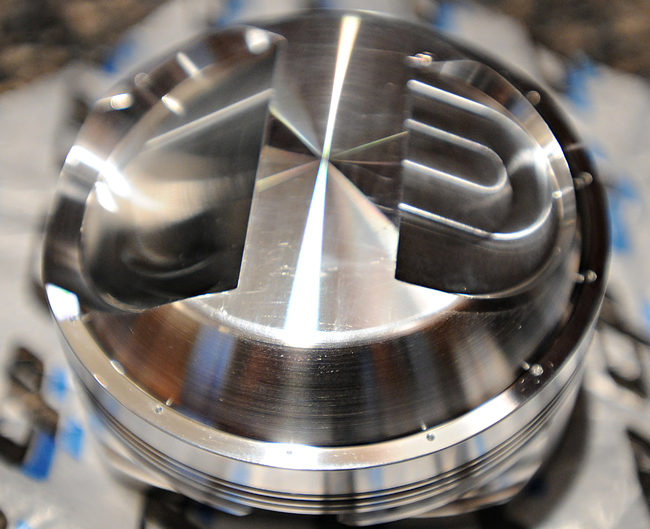
The block is a KB with a 0.250-inch raised cam, 55mm roller cam bearings, and oil to the lifters. The lifter locations are spread 0.100 to help with pushrod clearance, but the block has the factory 10.725 deck height and stock bore spacing. I cut the thrust bearing register wider to accept the 440 wide thrust bearing. It’s way wider than the late Hemi and helps keep the thrust alive. You have to run the thrust clearance wide with the aluminum block. A four-speed, or staying on the trans brake, really loads that bearing up. I also blended all the sharp corners and weird angles out of the entire oil, and water systems. All passages are smoothed and blended to keep down steam pockets in the water and oil aeration. The sleeves are 0.100 thick at 4.500, so going to the 4.565 bore leaves them in the 0.0685 wall-thickness range. Thin, but the KB block has such good sleeve quality and block aluminum backing it holds up just fine.
The oil system is wet using a Moroso super fueler deep pan with my own scrapers and baffles installed. The long skirted block makes oil windage control a chore, and it benefits from a dry sump less than other motors, so I stayed with a wet sump. I really don’t have room for a tank and long pump with factory inner fenders, and stock motor location. The oil pump is KB with everything blended and the spring pressure reduced to produce no more than 70 pounds of oil pressure
The cam is an LSM 4-7 swap for the 55mm bearings It has 0.535 lobes with 288 @ 0.050 on the intake and 306 @ 0.050 on the exhaust with a 117-degree lobe separation angle. The intake opens 28 BTDC and closes 80 ABDC. The exhaust opens at 89 BBDC and closes 37 ATDC. This cam is currently installed 1 degree retarded, though the cylinder pressure and power would be better 4 advanced. I’m a little nervous running E85 at higher pressure than where I am now. The cranking compression is only 190 PSI
The lifters are Crane Ultra Pro with pressurized rollers. We machined a 0.015-inch-deep groove between the oil holes in the body to get more oil up top than you get just letting the oil hole pass by the feed hole in the bore as it passes it moving up and down.
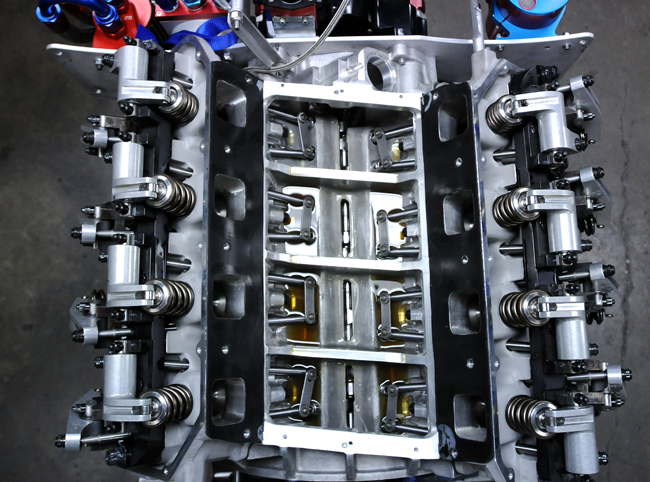
The pushrods are Manton salt nitrided in ½-inch and 5/8-inch diameters with 0.180 walls. The cam drive is a Jesel belt and the balancer is ATI with a Chrysler front.
The rocker gear is custom T D 1.7:1 intake and 1.6:1 exhaust, drilled to oil from the pushrod to the rocker body to the tips and springs. I’d recommend this mod to anyone using this rocker gear. The spray bars they come with my be OK for track only passes, but pushrods and springs will die a quick death with high spring pressure and continued operation without doing these mods, especially with high crankcase vacuum. Plus the supplied spray bars have very small openings that can get clogged fairly easily.
The heads are Stage V Millenniums originally ported by Jeff at Modern Cylinder Head. Jeff centered the ports on the guides, making the port locations symmetrical. Ted Fischer at Engine systems opened them up further and moved the ports over slightly to induce some more swirl and ad runner volume. You have to work around the pushrod tubes, so you just have to angle off using the exhaust tube as the pivot point. The intake tube intersects the bottom corner of the port so you have more room to work there. The flow numbers are good for this type head. We wound up with 542 CFM @ 0.900 and 340 @ 0.900 with a 2.4-inch titanium nailhead intake valve and a 1.94-inch titanium exhaust valve. The retainers are 0.100-up CV ultralight Super7 with 0.050-up CV Ti Super7 locks. Springs are PSI 1248 XL set up at 0.060 from coil bind with this cam. No oil goes through the head and the passages are blocked off. The chambers are 150cc.
Custom, 0.040-inch-thick Cometic head gaskets were used with a 4.570 bore with enlarged push rod openings, at 0.040 thickness. They’re only 0.005 larger than the bores so even though they’re dowel pin aligned I had to move them around by pin punching the alignment holes to keep them dead center of the bore. There’s not much left between the bores at that size.
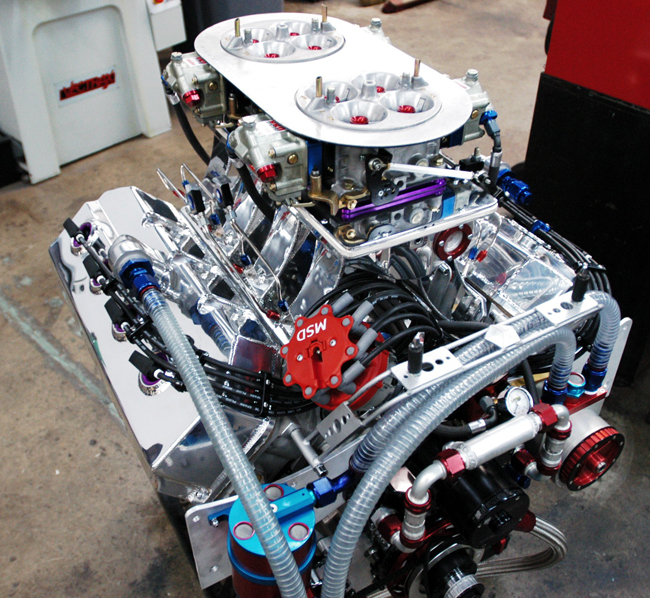
The intake is an older custom CFE unit with rectangular runners and a 2×4 clover Dominator top using Magnafuel shear plates. This is a weak spot, as the runners would typically have epoxy in them to make a radius down the corners. I’m using E85 and I can’t find an epoxy that will live in alcohol, and I don’t want the motor eating epoxy chunks as they fall out. More modern radiused runners would be worth real power and I think would safely put it over 1,300 hp. I plan to do this on the next go around with a bunch more cam. The heads will keep flowing over 1-inch lift so next time I’ll go out to 1.125 lift with an even wider center, maybe 119 and more ramp speed in my never-ending quest to make it completely unstreetable.
The carbs are Pro Systems E85 1,250 Dominators using alky drilled jets. The range of jetting is wild with weather changes going from around a 0.135 up to a 0.175 drill size in all 8 corners. I think weak carb signal for the volume of fuel required accounts for the range.
Cooling is reverse flow wth a Mezeire 55-GPM pump.
Crankcase vacuum comes from a Star machine mountain-motor pump. I try not to pull more than 15 inches since I’m using a wet sump.
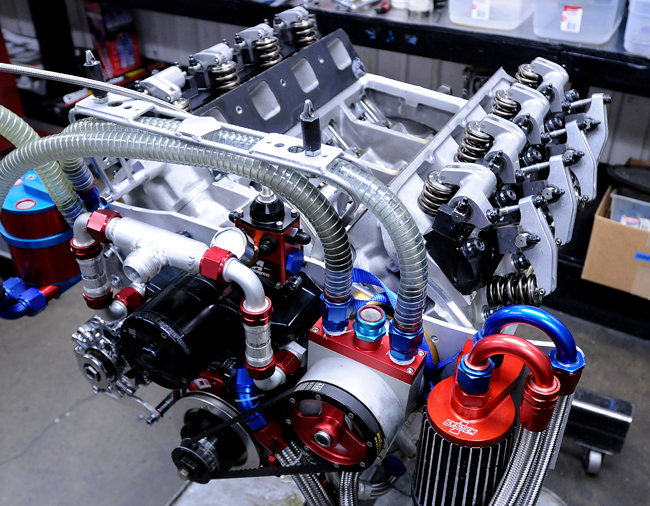
Ignition is a digitally controlled MSD 10 box with an offset distributor, Ford Cleveland cap, and an MSD crank trigger. I run 34 degrees advance total. The MSD 10 box is a close to a magneto as you can get. It produces something like 760 milijoules and will fire under extreme pressure and or high fuel loads. The motor can be dead rich, and aside from losing power it won’t stumble or missfire. The digital controller and fiberoptic number one cylinder pickup allow me to adjust individual cylinder timing too. Adjusting timing cylinder for cylinder helps because my headers had to fit a factory location and some of the cylinders don’t get exhausted as well as others. The headers are TTI raised-port Stage Vs with 2.250 tubes to 4-inch collector, ceramic outside and thermal coated inside. For a production header they really surprised me.
Peak power was 1,262 hp at 7,200 with over 1,000 lb-ft below 6,200, and the most I’ve made at the tire is 1,026. I won the Dynomax N/A class this year with 957 at the tire, but after testing with the hood off, and making a consistent 1,000-plus I was forced to put my hood on for the final round. The scoop is really close to the carbs, and after getting the car on the dyno and warming the drivetrain there was too much heat in the intake and the power dropped off to the 957. Going down the track the hood works just fine and feeds plenty of air. Being the ONLY one to have to run a closed hood was a little weird, but I still won, so who cares. The second place finisher in N/A was Richard Burdette in his Hemi ‘68 Dart. The pump gas 572 he ran is my old motor I had in the Cuda for the ‘06 Pump Gas Drags. It made 750 at the tire on pump gas. The weather at the final was terrible because of the hurricane remains passing through Missouri. It was hot and raining off and on all day with a record low baro for that day. Richard’s car made 821 in Atlanta in good weather during testing.
I really feel like this combo with a good intake, dry sump, 4 degrees advanced cam timing , and a real set of race headers would make 1350 or better, I kept the cam retarded because I don’t want to know where E85 will detonate.
